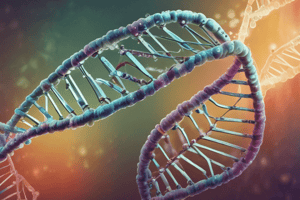Podcast
Questions and Answers
What does the 'D' in DNA stand for?
What does the 'D' in DNA stand for?
- Deoxyribose
- Deoxyribonucleic (correct)
- Deoxisugar
- DNAase
Which structure describes the shape of DNA?
Which structure describes the shape of DNA?
- Double helix (correct)
- Single strand
- Circular loop
- Triple helix
What are the components of a nucleotide?
What are the components of a nucleotide?
- Glucose, nucleotide base, and phosphate
- Fatty acid, glycerol, and nitrogenous base
- Deoxyribose sugar, phosphate group, and a nitrogenous base (correct)
- Ribose sugar, amino acid, and phosphate
What is the role of a gene in DNA?
What is the role of a gene in DNA?
What forms the backbone of the DNA molecule?
What forms the backbone of the DNA molecule?
Which nitrogenous base is NOT found in DNA?
Which nitrogenous base is NOT found in DNA?
Which of the following is characteristic of purines?
Which of the following is characteristic of purines?
What is the negative charge in the phosphate group of DNA responsible for?
What is the negative charge in the phosphate group of DNA responsible for?
Flashcards
What is DNA?
What is DNA?
Deoxyribonucleic acid, a molecule that carries genetic information in the form of genes.
What is a gene?
What is a gene?
A segment of DNA that codes for a specific protein, responsible for a particular trait.
What is the structure of DNA?
What is the structure of DNA?
The shape of a DNA molecule, resembling a twisted ladder.
What are sugar-phosphate backbones?
What are sugar-phosphate backbones?
Signup and view all the flashcards
What are nitrogenous bases?
What are nitrogenous bases?
Signup and view all the flashcards
What are the four nitrogenous bases in DNA?
What are the four nitrogenous bases in DNA?
Signup and view all the flashcards
What is a nucleotide?
What is a nucleotide?
Signup and view all the flashcards
How does DNA replicate?
How does DNA replicate?
Signup and view all the flashcards
Study Notes
DNA Structure
- DNA stands for deoxyribonucleic acid
- DNA is a nucleic acid that carries genetic information
- A segment of DNA is called a gene. A gene codes for proteins.
DNA Structure Objectives
- Students will be able to explain the meaning of each letter in DNA
- Students will be able to discuss and label parts of a DNA molecule
- Students will be able to name the parts of a nucleotide
- Students will be able to identify the 4 bases
- Students will be able to explain the function of DNA in a cell
The Shape of DNA
- The shape of a DNA molecule is a double helix
- The shape of DNA can be thought of as a twisted ladder
A Closer Look at DNA
- DNA is more complex than a simple twisted ladder
- DNA has a complex molecular structure with various components and connections.
The Sides of the DNA Ladder
- Each side of the DNA ladder is called a sugar-phosphate backbone
- The sugar-phosphate backbone is connected by covalent bonds
- The backbone consists of a phosphate group (with a negative charge) and a deoxyribose sugar (a pentagon-shaped sugar).
The Rungs of the DNA Ladder
- The rungs of the DNA ladder are made up of nitrogenous bases
- Nitrogenous bases are bonded to the sugar
- There are four different kinds of bases in DNA
The Bases: Purines and Pyrimidines
- Purines (adenine and guanine) have a double ring structure
- Pyrimidines (cytosine and thymine) have a single ring structure
- A purine always pairs with a pyrimidine (A with T, G with C)
Nucleotide
- A nucleotide is the building block of DNA
- A nucleotide comprises a deoxyribose sugar, a phosphate group, and a nitrogenous base.
Putting it Together
- The deoxyribose sugar of one nucleotide bonds to the phosphate group of another to form the sugar-phosphate backbone
- All bases are directly attached to a deoxyribose sugar
- The nitrogenous bases from one sugar-phosphate backbone bond to the bases of the other backbone to create base pairs
- Adenine (A) forms two hydrogen bonds with Thymine (T)
- Guanine (G) forms three hydrogen bonds with Cytosine (C)
Quick Practice and Complementary Strands
- If given a strand of DNA, the complementary strand can be determined based on the base pairing rules (A with T, G with C)
- Example: If one strand is ATAGGCAT, then the complementary strand is TATCCGTA
One Final Look
- DNA has a precise structure with a double helix shape
- DNA has a characteristic distance and width
- The double helix is also described as antiparallel, meaning the two strands run in opposite directions.
- Hydrogen bonds form between complementary base pairs(A-T, G-C) connecting the two strands of the DNA double helix
Function of DNA
- DNA stores genetic information
- The sequence of bases on the DNA strand acts as a blueprint for creating hundreds of thousands of different proteins.
- These proteins are essential components of living organisms.
Studying That Suits You
Use AI to generate personalized quizzes and flashcards to suit your learning preferences.




